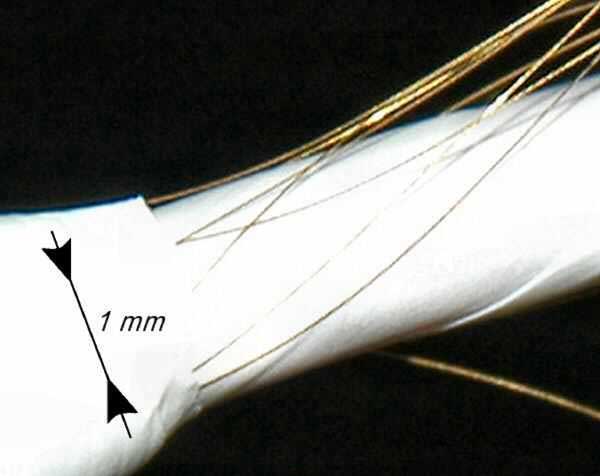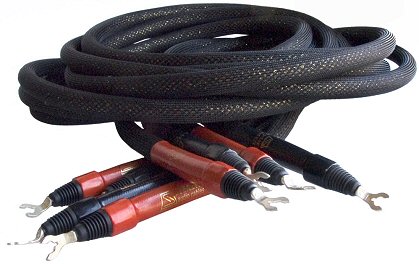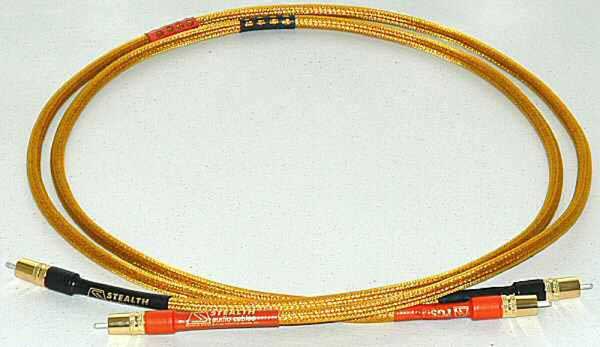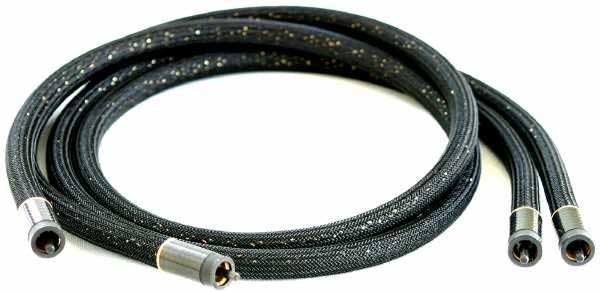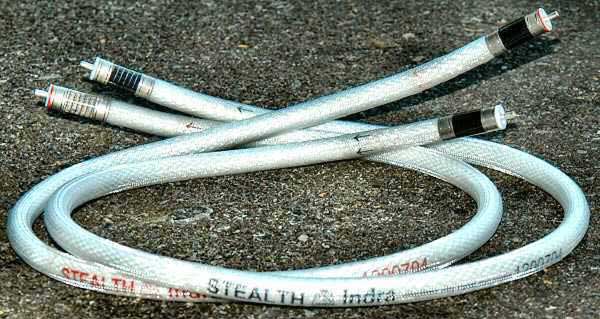|
You are reading the older HTML site Positive Feedback ISSUE march/april 2007
STEALTH Audio
Cables - An Unobtainium Experience
From our first meeting at CES 2002, I have developed the deepest respect and admiration for the man behind STEALTH audio cables, Serguei Timachev. Russian born and raised in the former Soviet Union, he immigrated to the U.S. in 1991 and initially settled in Kalamazoo, Michigan, not too far from my current home in the Midwest. Though we have discussed many things over the years at shows, including my taking a closer look at his product line, the project just never materialized: Until now! For the first time in my more than three decades in this industry, I can truthfully say that I have been witness to a product fashioned of certifiable unobtainium. No, really! Not just hinted at, not alluded to, not falsified, not a mere term bandied about in lieu of disclosing a proprietary substance, as has often been the case in the past by some in the fine audio community. No, the STEALTH Indra is honestly made from a material so rare, so hard to fashion, at such outrageous cost, that it is quite likely to be never seen again once this limited supply has been exhausted.
The Indra utilizes just nine conductors of an ultra fine 46 AWG wire, assembled in Serguei's proprietary distributed Litz, multi-layered geometry. That American wire gauge equates to something on the order of 0.001 inches in diameter (0.00254 millimeter), roughly 1/3rd the thickness or 1/10th the cross-section of the thinnest of human hairs. Got that? Besides being almost unmanageably fine, the conductors are produced from an amorphous metal alloy of platinum, molybdenum [1}, and gold. The one word that should really stand out for you in that last sentence, aside perhaps from molybdenum, should be amorphous. An amorphous metal is a metallic material that possesses a disordered atomic-scale structure and is usually an alloy rather than a pure metal. What distinguishes an amorphous metal from standard metals is its non-crystalline structure. Produced directly from a molten liquid state by extremely rapid cooling (over a million degrees per second, according to Serguei), such non-crystalline materials are commonly referred to as metallic glasses or glassy metals. Where the typical metal has a highly ordered arrangement of atoms, amorphous alloys contain atoms of significantly different sizes and acquire a decidedly disordered structure. This results in both a very low free volume and a viscosity that is orders of magnitude higher than other metals and alloys when in a molten state. This higher viscosity prevents the atoms from moving freely enough to form an ordered lattice and contributes significantly to both low shrinkage during the cooling process and a remarkable resistance to plastic deformations. As a non-crystalline material, the absence of grain boundaries, the Achilles' heel of crystalline materials, it is also much tougher and less brittle, with better resistance to wear and corrosion. Other properties of amorphous metals can be phenomenal; one strand of the material used for the conductors in the Indra can carry over 100 milliamps (mA) of current! Ok, so I admit that I didn't know all this when they first arrived, but here is what I learned when a box containing one 8' set of Hybrid MLT loudspeaker cables ($2500), and three one meter single-ended interconnects, one each PGS ($1000), Nanofiber ($2000), and Indra ($5750), arrived.
The light and highly flexible Hybrid MLT Loudspeaker Cable I inserted the Hybrid MLTs and listened for some time to get a handle on that change. My first impressions of that cable are now worthless, as what I was hearing was MORE of the character of the prior cable sets, both selling for right around $2K, and the current interconnects. Though my first sense of them was quite good, it was, as I was soon to learn, woefully incomplete. As such, I will not waste time with those initial and flawed impressions. What I was assuming were the limitations of the Hybrid MLT were actually imperfections or blemishes in cables further upstream. I never got the true sense of this cable until after I installed the STEALTH interconnects. Post Indra, I found a new appreciation for this remarkably light and exceptionally flexible loudspeaker cable. After removing the other non-STEALTH interconnects from my system, I can say that they are the most uncolored and neutral speaker cable I've yet had in house, including the nearly three times as costly PranaWire Cosmos. Where the luscious PranaWire had evoked sensations similar to those of the best that tubes have to offer, the Hybrid MLTs seemed simply to vanish: I was hard pressed to ascribe a single faulty attribute to them. They pull a vanishing act unlike anything else in my experience. While descriptors such as neutral, fast, transparent, and effortless are all fitting, they are still somewhat deficient. The Hybrid MLT has proved to be a very alluring and useful reviewing tool. That crafty Serguei!
The pure gold PGS It was time to begin the interconnect shuffle. I first inserted the STEALTH PGS, fabricated of pure (99.997%) gold, between my phono stage (the DAS Phone ONE or the ModWright SWP 9.0SE) and preamp (the ModWright SLP 9.0SE). Interesting. More space, and all more naturally layered and better focused. Extension at both extremes seemed more detailed and complete. They offered a more relaxed, more organic overall presentation and a bit more clarity. Harmonic structure seemed more natural, as though transients, in particular those of the micro scale, were being handled more faithfully. I next moved the PGS to the link between my optical disc player (McCormack Audio UDP-1 Deluxe) and my preamp. Much more of the same attributes I noticed with them between phono stage and pre, but it manifest in the midrange as an overall smoothness and naturalness. Very, very nice.
All carbon, no metal. The Nanofibers At this point, I installed the Nanofibers (pure carbon) between the phono stage and preamp. These have a different perspective. Overall, I found them a bit warmer than the PGS, with a very fluid, liquid midrange. Pianos and female vocals were remarkably lifelike in tonality and size. However, some of the sparkle and shimmer that the PGS had conveyed had been minimized. I suspected that perhaps they handled the highest frequencies in a less faithful way than the PGS had. By now, I was very curious about the Indra. A slight rearranging of my components was necessary so that I could have the one-meter Indra's span the space between my preamp and amps (CIA D-200s or the VMB-1s) and still maintain their isolation integrity. HOLY FREAKIN' SHITE, man… What a leap forward. It is MORE REMARKABLE than you may have read or heard about. To say that it is the least invasive cable I've ever heard is a gross injustice. It is so invisible, so natural, and so transparent, as to still be beyond my ability to describe accurately. It was immediately apparent that some overall relaxation had taken place, EVERYTHING sounded much less “mechanical," and effortlessly natural. This affect was not subtle. Imagine listening to music at a low volume with an air purifier of a fan running nearby. The mechanical sound generated by the running motor and spinning fan blades used to move the air by that device had been a contiguous part of the music, blended in with it, becoming an inseparable yet subliminally unsettling and disturbing component of the sound itself. Inserting the Indra's was like having someone switch off that device, removing a mechanical contaminant previously ignored because had been so pervasive! How extraordinary.
The remarkable, almost indescribable Indra The soundstage had taken on a much more concise, precise nature, exploding into the room with reshaped images. Instruments had a more natural existence, both on their own and in their association with other instruments. Post Indra, every instrument had an inescapable correctness of size, recording permitting. Prior to their insertion, most instruments shared a homogeneousness of relative size and spatial interrelationship. Violins, cellos, double basses, guitars, banjos, et. al., had been roughly equivalent in image size and with their interrelation to one another. With the Indra, violin voices were subtly smaller than cellos, double bass voices convincingly larger than cellos—indisputably and consistently, again, recording permitting. And, their relation to one another in space took on an eerie affirmation of those more correctly sized and located voices.
After several weeks of reveling in the Indra's contribution to (or more appositely, their lack thereof) discovery and investigation, I began to dread what certainly had to be the next step in my evaluation process. It was with no little reluctance that I had to admit that was time to employ the audio analyst's© fourth audio axiom—subtractive evaluation. Simply put, what this tenant purports is that often the effects of any change to a system are most readily and graphically noted when that change is reversed by the removal of the component under evaluation and you revert to the previous system assembly. Even this method is tainted, but the least sullied I've yet uncovered. But the evaluation had to be inclusive, so out it came. In its place I substituted three other very good one meter single-ended interconnects that I alternately use as reference in the place where the Indra had stood. The three carried different retails; the first sold for just under $1K, another was just over $1k, and the third retails for $2500. Yet no matter which cable I employed, and each has varying strengths, I was appalled at the transformation. To my chagrin, the alteration was every bit as dramatic as I had anticipated. The first difference is still very hard for me to verbalize. There was an unmistakable discontinuity or granularity, a non-wholeness or sense of fracturing, imparted across the entire spectrum of sound. The only way I can describe it is that it was as though someone had combined a very low powered white noise with the music signal, imparting a contrived, aberrant, and disassociated sound from lowest to highest frequencies. Someone had switched that fan beside me back on! That is as close as I can get to conveying the sensation. Also immediately obvious was the overall apparent loss of speed. This was manifest by a slight congealing of harmonics with fundaments, yielding a slight loss to both the individuality and focus that the Indra portrayed so effortlessly. System immediacy had taken a large step backward. Now, there was much less “there," there! Transients seemed to suffer muffling or constriction. Attack had become somewhat slurred, robbing voices, particularly that of piano, of much of the sparkle that had brought them to life with the Indra. After speaking to Serguei about this, I have to agree with him that removal of the Indra leaves the impression that musical pitch is slurred. You are left with a sensation that instruments are somehow out of tune. Overall, volume seemed somewhat diminished sans the Indra. I had not touched the volume control at any time during my experiment, preferring to use mute and power switches where appropriate to protect components from the potential dangers of cable switching. Yet, the impression was one of lowered output. This may merely have been an artifact of the previously noted loss of individuality, focus, and speed, but it was readily perceptible. Something that I am particularly sensitive to, staging and imaging, took a strong hit too. Staging was foreshortened and images flattened, with individual image sizes homogenizing again. Staging was no longer as nuanced and images were more amorphous sounding. Space between notes was not as fleshed out, with a striking lessening of the sense of the “air" between and around individual instrumental voices. In the Indra, Serguei Timachev has delivered so much more than just something special. This cable borders on an absolute and represents both a distillation of purity and a level of performance previously unheard and unobtainable; it is a true archetype. Thinking back on my time with the superb PranaWires, as compelling and musically engaging as they were, searching both memory and my notes, I cannot find any evidence in either collection that would allow me to conclude that they were anything quite like the experience I'm having at the caprice of the Indra's
Even though I don't know how I will afford even a single set …for me, at this point in time, they are the paradigm of an audio interconnect. And I don't mean by some ever-so-slight margin. Rather, they excel by a daunting order of magnitude. In over 30 years of auditioning fine audio components and cables, I have never once before felt comfortable uttering such words. Yet I have no concern at making such a statement about Serguei Timachev's stirring triumph, the Indra. In experiencing the Indra, I feel at once honored and mortified. I am privileged in having had my ears opened to what is achievable while at the same time being cursed by having to find a way to afford such a remarkable and musical cable. Get ‘em while you can. Once this batch of unobtainium is spent, this level of performance will be gone, likely never to be replicated. [1]Pure Molybdenum is silvery white in color, fairly soft, and has one of the highest melting points of all pure elements. It is a transition metal, silvery white in color, with characteristics so similar to lead and graphite that for many years before it was "officially discovered," it was used accidentally in place of them.
Stealth Audio Cables
Interlink House, Inc. Hybrid MLT loudspeaker cables/8' set - $2500 PGS Interconnect/1 meter single-ended - $1000
Nanofiber Interconnect/1 meter single-ended - $2000
|


